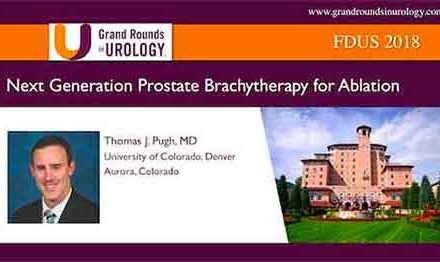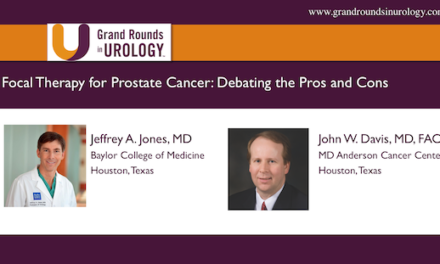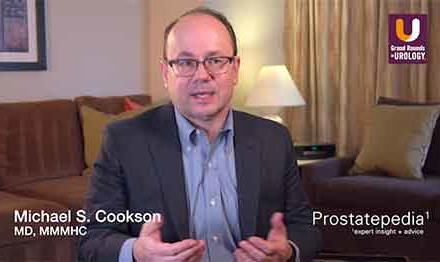Dr. James A. Eastham presented “Vascular Targeted Photodynamic Therapy for Prostate Tumors” at the 27th annual International Prostate Cancer Update meeting on Wednesday, January 25, 2017.
Keywords: prostate cancer, vascular targeted photodynamic therapy, focal therapy, Gleason Score, ablation
How to cite: Eastham, James A. “Vascular Targeted Photodynamic Therapy for Prostate Tumors”. January 25, 2017. Accessed Dec 2024. https://dev.grandroundsinurology.com/vascular-targeted-photodynamic-therapy-prostate-tumors
Transcript
Vascular Targeted Photodynamic Therapy for Prostate Tumors
I will be talking about another energy source if you will of providing ablation of prostate tissue. This is vascular targeted photodynamic therapy. I will start with one of two questions, so which of the following is true about focal therapy in general? Focal therapy for prostate cancer is FDA approved, and I will let you read the other three and you can vote.
Okay, so a smattering of things. Actually answer three is correct and we will go through that. Most folks getting focal therapy are continent and very few actually require surgical procedures, so three is correct. Let’s go to the next one please. And this is specifically for a vascular targeted photodynamic therapy and, again, you can read the responses and choose accordingly. Okay, so again a smattering of responses. Actually the correct answer is number two. So we will go through this and there is obviously a lot to learn about the new technologies so we will go through all of this.
So, vascular targeted photodynamic therapy basically uses a chroma-4, which is based on chlorophyll actually. It’s called padeliporfin. It’s called a drug from now on, and it’s specifically activated by a specific wave length of light, a laser delivered light, and that activates this compound locally. And it basically results in vascular occlusion, so this is not a strategy that generates heat or cold, and that is one of the proposed advantages of vascular targeted this that there is not collateral damage, and that basically you can destroy the lesion you are planning on destroying without having to worry about other surrounding tissues such as the neurovascular bundle or the urethra or other important structures from being damaged.
It’s basically done like any other brachytherapy template-based strategy, so there is a transrectal ultrasound probe placed in the rectum to visualize the prostate. There is a brachytherapy template that is utilized to guide cannula fibers into the prostate, and you map out an area that you wish to ablate. There are certainly guidance strategies, and depending upon the volume of tissue one wants to destroy and the location of that tissue, a computer algorithm will tell you where to place the fibers. The fibers do have different lengths in terms of how much light energy they will deliver, so you can set up a treatment plan to very specifically target an area within the prostate that will then be destroyed.
The light enhancing element, the padeliporfin or whatever it’s called, is the agent that is given about ten minutes before you place the light on, so it’s a relatively quick procedure in terms of getting the patient treated. These are the various types of fibers that can be used, and at least from a science standpoint you want what is called the light density index to be greater than one. And that is determined by the volume of the tissue that you want to ablate, and then the sum of the fibers in terms of the length of the energy that you will be delivering over that period of time. And, again, there is a software program that tells you where to place these fibers and the length of the individual fibers based on the treatment plan.
So this is a two dimensional image of the ultrasound, but basically it shows you where the fibers need to be placed, thus how many fibers, and then the length of those fibers. And that gives you a formula that allows you to calculate if you will destroy that tissue appropriately. This is flipped from the cartoon on the other image, but this was a left-sided ablation. And you can see that you can ablate large areas of the prostate with this technology. The resultant biopsies basically show necrosis of the tissue. The time lap studies of this demonstrate that it is a vascular generated necrosis.
There are really no heat changes that are associated with this technology. And as with all of these ablated strategies, whether it’s cryotherapy, electraperation, you can throw in radiation therapy, they all work in terms of destroying tissue. So some of the nuances of, well, do you use one versus the other versus the other, it depends on what you are trying to accomplish and what you have available to you, but they all kill tissue. That is for sure.
I am going to spend most of the time during this presentation talking about a recently published phase III study with Dr. Gammella [phonetic] if he is still in the audience. He actually commented on this article in Urology Times, but it was basically looking at the patients who we would otherwise consider candidates for active surveillance. So you can argue whether that is the best patient population to study, but this was the study that was performed that was done in Europe. It was led by Mark Emberton who is certainly a big proponent not only of MRI, but also MRI-guided treatment strategies.
Fairly low risk patients when you look at the patient population that was studied. So basically no one had any Gleason grade 4, certainly no Gleason grade 5 in their biopsy. It was small volumes of Gleason score 6 all with PSA’s under ten. Very few had actual palpable lesions, and then from a technical standpoint just a limit on the prostate size. The exclusion was basically anybody that didn’t meet the eligibility criteria, prior treatment for their prostate, whether it be a TURP, and no one could be on any type of hormonal type of therapy.
The primary endpoints, there were co-primary endpoints. The first was an absence of a positive biopsy at the 24 month mark, and the other was the time to treatment failure. The time to treatment failure is basically defining treatment failure based on all of these outcomes. So, again, at 24 months you wouldn’t expect much metastasis or death or progression to T3, but there is a PSA endpoint, and primarily a progression to a higher Gleason score. So those were the co-primary endpoints.
The secondary endpoints, they did do biopsies at 12 months. The patients that had a positive biopsy at 12 months that were in the original treatment arm could be retreated. It actually ended up only being about 5% of the patients, but retreatment was allowed. And then they looked at the PSA levels, MRI findings, etc. A well-balanced study, nothing dramatic, there were 200 or so patients in each arm, most were Caucasian, and body mass indexes were pretty much irrelevant.
But because this is a low risk patient population, so the patients that were otherwise candidates for active surveillance, the vast majority, 85+ percent were clinical T1C’s, and most had modest PSA elevations in the five to six range. the numbers of positive biopsies based on the eligibility criteria was only about two, and most had by definition a Gleason of six or less. There were a few that were still called Gleason grade two’s, but essentially all of therapy enrollment were Gleason 6. And three-quarters of them had a unilateral disease only. If the patients had bilateral disease, both lobes of the prostate were treated.
So the co-primary endpoints as I mentioned, the first was a negative biopsy at 24 months. And if one looks at the outcomes basically the TOOKAD is the treatment arm versus the surveillance arm, so there were far more patients in the treatment study. About half of them actually had a negative prostate biopsy compared to the surveillance group where only a small minority had a negative biopsy. And the second primary endpoint was this progression endpoint. Each of these were listed out. Most of the people that progressed were based on, of course, biopsy features, and very few were based on PSA or clinical score progression as I mentioned. None were going to develop metastasis or death within a two year time frame, but most had progression to a Gleason 3+4, and some had more than three biopsies positive.
But regardless of these individual characteristics, it all favored the patients that were treated with a photodynamic therapy. So basically fewer patients had either a positive biopsy at 24 months or met one of these definitions of patient progression. If one looks at, again, the other aspect of this was how long did it take these patients to progress, again, a delay in progression even in those patients who did progress based on treatment, whether they were just active surveillance versus the photodynamic therapy.
So in essence, setting the clock back if you will in those patients treated with the photodynamic therapy, even though this was a low risk patient population. This curve is a bit strange. It’s based on the biopsies at 12 and 24 months. That is why there are these steep drop-offs, but basically the patient population that received the photodynamic therapy were less likely to progress because they were less likely to meet either of the co-primary endpoints. This did reach statistical significance, of course, and far fewer patients as we will see.
And this developed higher risk disease, so in terms of the biopsy endpoint, if you looked at the patients who progressed to Gleason 7 it would be in many centers an indication that active surveillance had failed. About twice the number of patients that were just under active surveillance relative to the patients who had received treatment, very few patients went on to 4+3 rather than 3+4, but again it favored the treatment arm.
One criticism of this study is that there is this fairly high progression rate at just two years of active surveillance for what is a relatively low risk population. A single core of Gleason 6 that at two years had almost half of the population now having a Gleason score of 7, and that is a little bit quirky, but it was a randomized trial. The pathology was reviewed, so the numbers are the numbers, but relative to other active surveillance populations with similar low risk patients, that is a pretty high number again. I am just pointing that out.
If you look at the initiation of radical treatment, so the patients who again were active surveillance patients, some were treated with a standard active surveillance protocol, and the others treated with a photodynamic therapy, about 30% of the patients in just the active surveillance arm ended up being treated, and only about 6% of the photodynamic therapy patients, again, at two years. One can argue again that a 30% treatment rate after just two years of active surveillance in a relatively low risk population is a pretty high rate of treatment.
I think most would have a 5% to 10% treatment rate, but again a randomized population and their numbers are the numbers. If one looks at some functional outcomes, basically the patients did very well with what is a focal therapy and that is the advantage of doing a focal treatment rather than a whole gland treatment. If you look at the active surveillance population, they basically stated their baseline functionality throughout the two years of the study, there was a transient worsening of urinary function in those patients that were treated with the photodynamic therapy, but basically they then improved over time.
It was probably a reduction in gland volume as the result of the tissue being destroyed. If one looks at sexual function, there was a worsening of sexual function. Again, the active surveillance population had about a slight decline, age-related of course. They didn’t have any treatment. The patients that were treated with the photodynamic therapy had an initial decline. They had some improvement, but again relative to the active surveillance population, there is a little bit of decline, but not dramatically.
If one looks at the safety profile, certainly with the treatment as compared to active surveillance, the patients had more urinary dysfunction. These are the ones that reached essentially clinical significance, and then ejaculatory failure or erectile dysfunction, etc, again the active surveillance patients of course receiving nothing is not going to have a significant impact on your quality of life receiving something even if it’s a focal something does at least transiently have a negative effect.
If one looks at the more severe ─ compare these two columns ─ there is basically very little difference between the active surveillance arm and the treatment arm in terms of grade III or higher side effects. So, again, it’s a relatively safe treatment, some transient changes in the quality of life, more significant with erectile function than urinary function, and most importantly, an improvement in oncologic outcomes.
So the authors concluded from the study that basically it’s a first trial, of course. There was a substantial reduction in progression primarily by preventing higher grade cancers. Many more patients converted to a negative biopsy because they received treatment. There was a substantial reduction progressing to aggressive or whole gland therapy, 30% versus 6%. And then the safety and the quality of life profiles were at least acceptable.
So at least from the photodynamic therapy, you know whether this was the right treatment population, you know should we be focusing on active surveillance patients one could argue. But at least it is a randomized phase III study that at least will show in selected patients on active surveillance perhaps the higher volume patients that perhaps this type of treatment may be of some benefit.
Now just switching gears a little bit, this is just basic science laboratory. It comes out of Jonathan Coleman’s lab, who has done most, if not all, of the work on the photodynamic therapy at Memorial. What he did was he treated these LNCaP tumors, so these prostate cancer tumors generated in mice. And what he saw was that when they looked at the genetic stuff that goes on in these things that many of the androgen response elements were actually stimulated or increased with photodynamic therapy.
And what that resulted in is that one could hypothesize if some androgen deprivation therapy was utilized that that may improve outcome, and that since photodynamic therapy enhanced a survival pathway by blocking that survival pathway in these androgen regulated genes that perhaps the outcomes would be improved. And that is basically what he showed in a relatively small study with mice, but again looking at the control versus those who received hormonal therapy alone, those that received photodynamic therapy alone versus the combination, again, the combination arm of combining the androgen deprivation therapy utilized before the mice were treated with the photodynamic therapy, there was a much larger reduction in the tumor volume compared to either of the treatment arms than the control arms.
So, again, it suggests that the combination therapy in moving forward, short term hormonal therapy followed by the photodynamic therapy may actually be an enhancement of the overall treatment pathway. So there certainly is compensatory upregulation of androgen receptor signaling and that by blocking that pathway you actually improve outcomes.
So, in summary, I think focal therapy in general effectively ablates prostate tissue. It doesn’t matter what energy source you use. You can kill the tissue. I think how much tissue we kill, how we target it and how we follow these patients to have a meaningful outcome, then those are the questions that remain. Certainly focal therapy has a better quality of life outcome than whole gland strategies, and which patient population will best be served by focal therapy, what are the appropriate endpoints, I think that is what needs further discussion and has yet to be determined.
So with that, I will finish my presentation.
ABOUT THE AUTHOR
James A. Eastham, MD, FACS, is the Peter T. Scardino Chair in Oncology and Chief of the Urology Service in the Department of Surgery at Memorial Sloan-Kettering Cancer Center in New York. Dr. Eastham received his medical degree from the University of Southern California, Los Angeles. He completed an Internship in General Surgery and a Residency in Urology at Los Angeles County+USC Medical Center. He went on to complete a Fellowship in Urologic Oncology at Baylor College of Medicine in Houston, Texas. Prior to his appointment at Memorial Sloan-Kettering Cancer Center, Dr. Eastham was an Assistant and Associate Professor in the Department of Urology at Louisiana State University in Shreveport and Chief of Urology at Overton-Brooks Veterans Administration Medical Center in Louisiana.
Dr. Eastham’s research has focused on the prevention and treatment of prostate cancer, and he has a particular interest in improving oncologic and quality-of-life outcomes after radical prostatectomy. He has authored or co-authored over 300 articles which have appeared in peer-reviewed journals such as the Journal of the American Medical Association, the Journal of Urology, the Journal of Clinical Oncology, Urology, and Transplantation. In addition, he has authored numerous book chapters, reviews, monographs, and abstracts. He is a Fellow of the American College of Surgeons and a member of several professional societies, including the American Urologic Association, the Society of Urologic Oncology, and the Societé Internationale D’Urologie.





